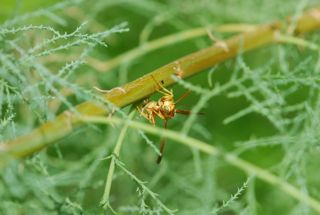Some of you may remember from the Academy of Science and Technology Blog Carnival 3 post that we are participating in the The Great Sunflower Project.
We got our package of lemon queen sunflowers (Helianthus annuus) in the mail, planted them and were pleasantly surprised when they started to grow like crazy.

This morning I’m happy to report the first bee. No, the flowers haven’t opened yet, but here is a tiny sweat bee resting on a leaf.

It is about the size of a pencil lead. It has been visiting nearby flowers. Can you see the pollen?

A parasitic wasp was also sitting on a sunflower leaf.

Are these insects merely resting in the warm sun?
A clue to what they may be doing comes from the black spots you see on the sides of the photos near the base of the leaves.

Those are ants.
What are the ants doing? Now, many people might think the ants are “eating the plants.†In a way the ants are, but not by chewing on leaves or harming the plant in any way.
It turns out sunflowers have extrafloral nectaries. As I explained in a previous post, extrafloral nectaries are structures on the plant in places outside of flowers that provide nectar for insects, often ants.
Ants of the Southwest some great photographs of ants sipping nectar from the extrafloral nectaries of a sunflower. Photo 1 and Photo 2. Notice how hairy sunflowers are.
Sometimes bees and wasps may take advantage of the sweet liquid nectar as well.
Just think, insects get their breakfast from a plant and not a flower in sight.







